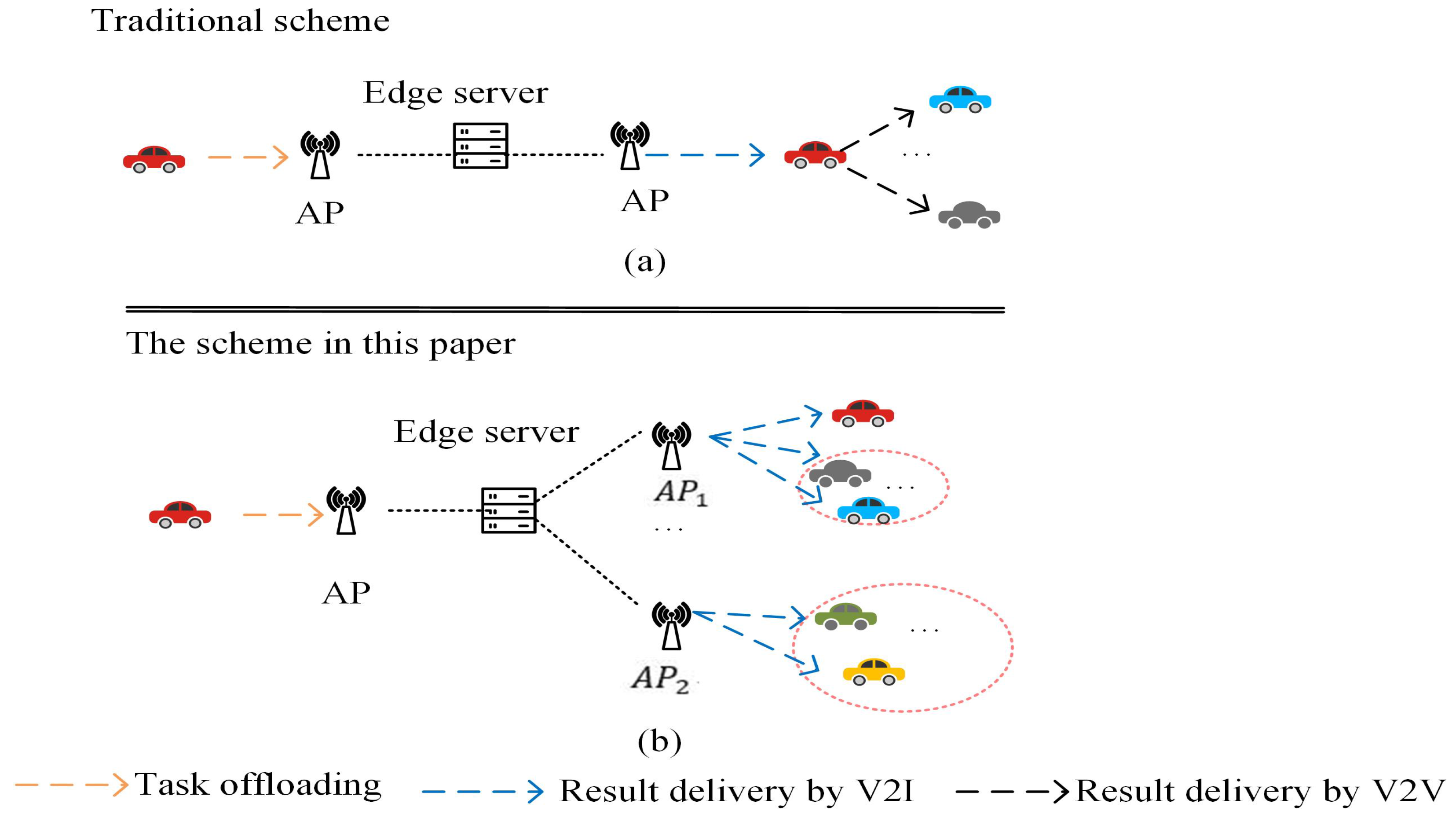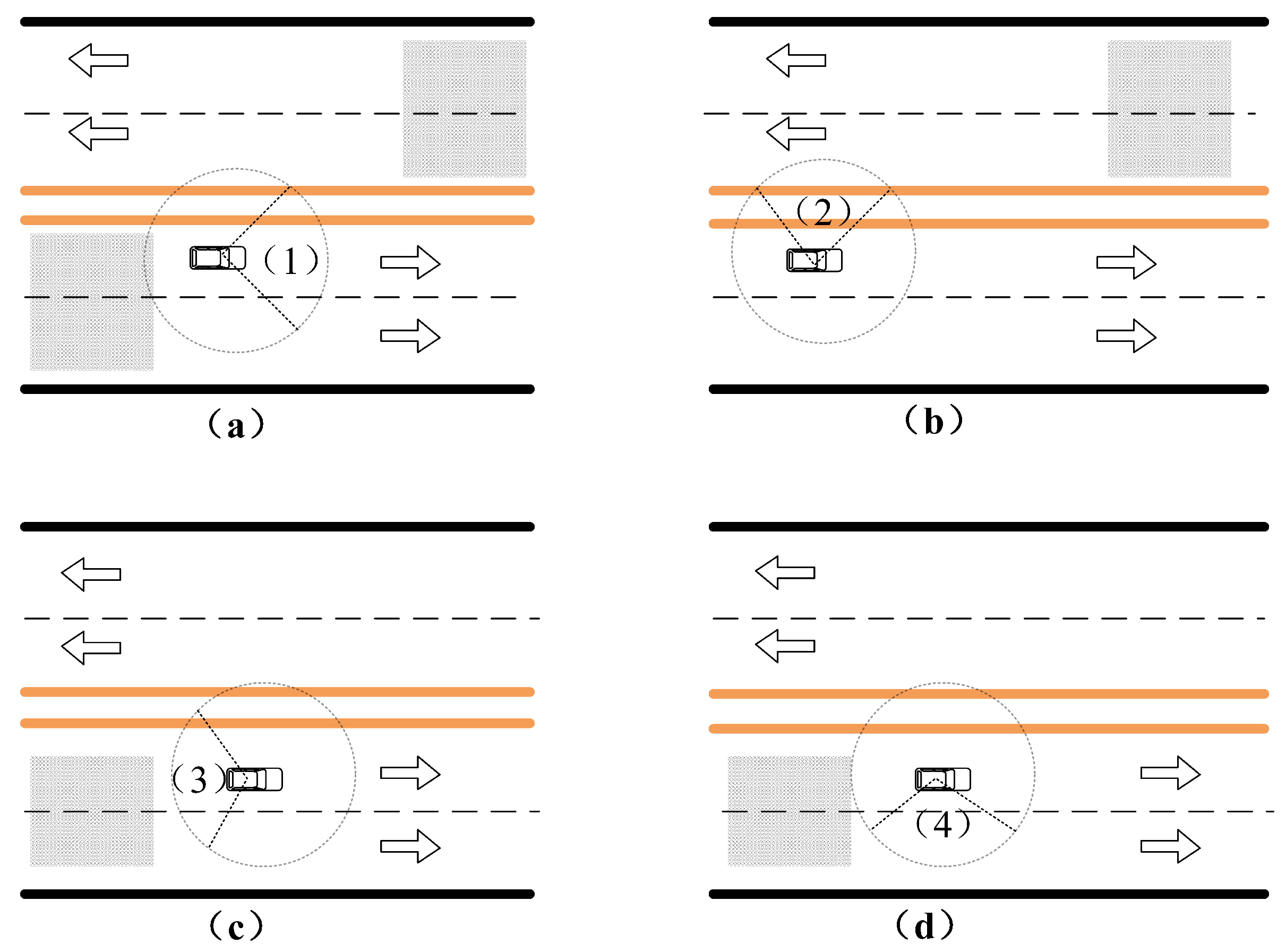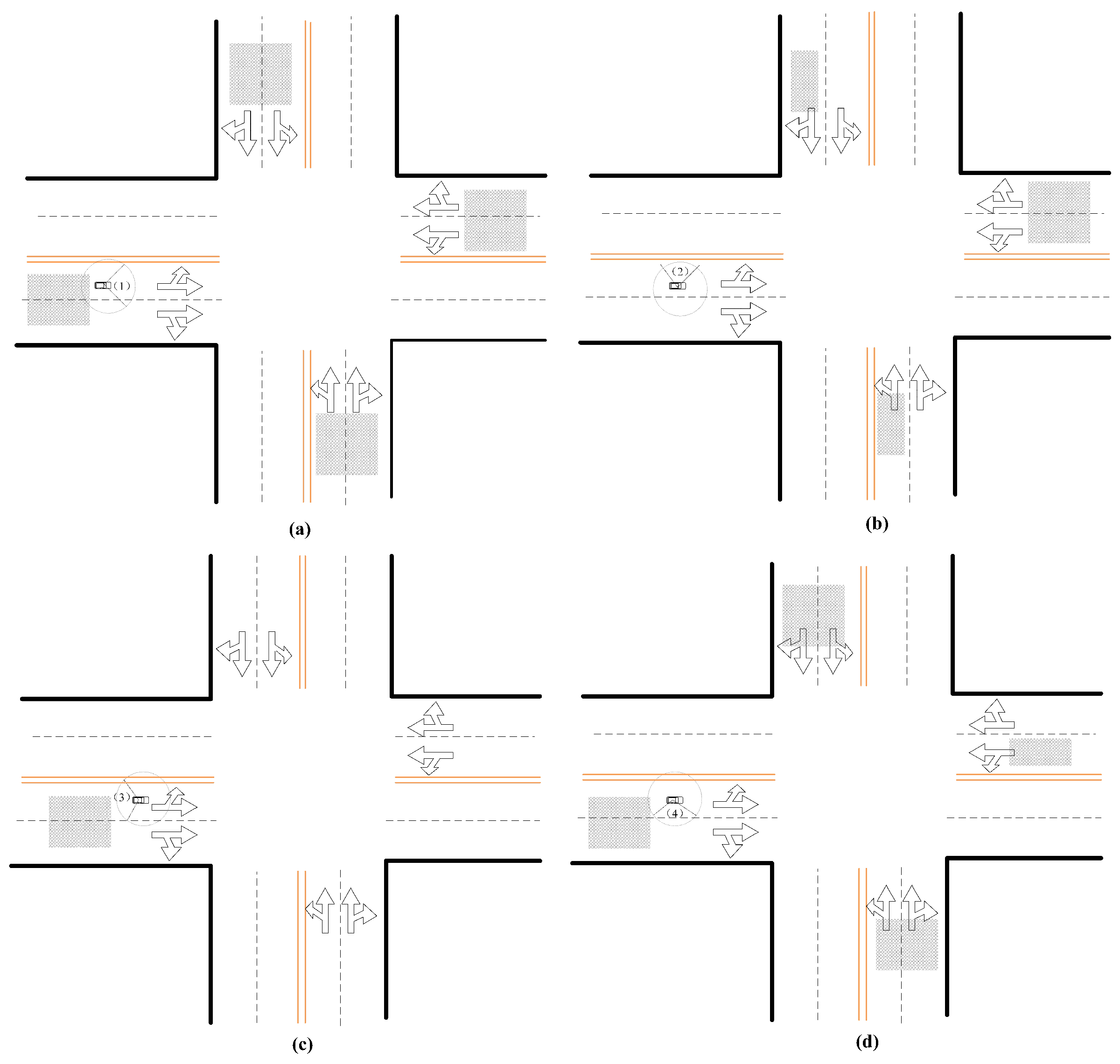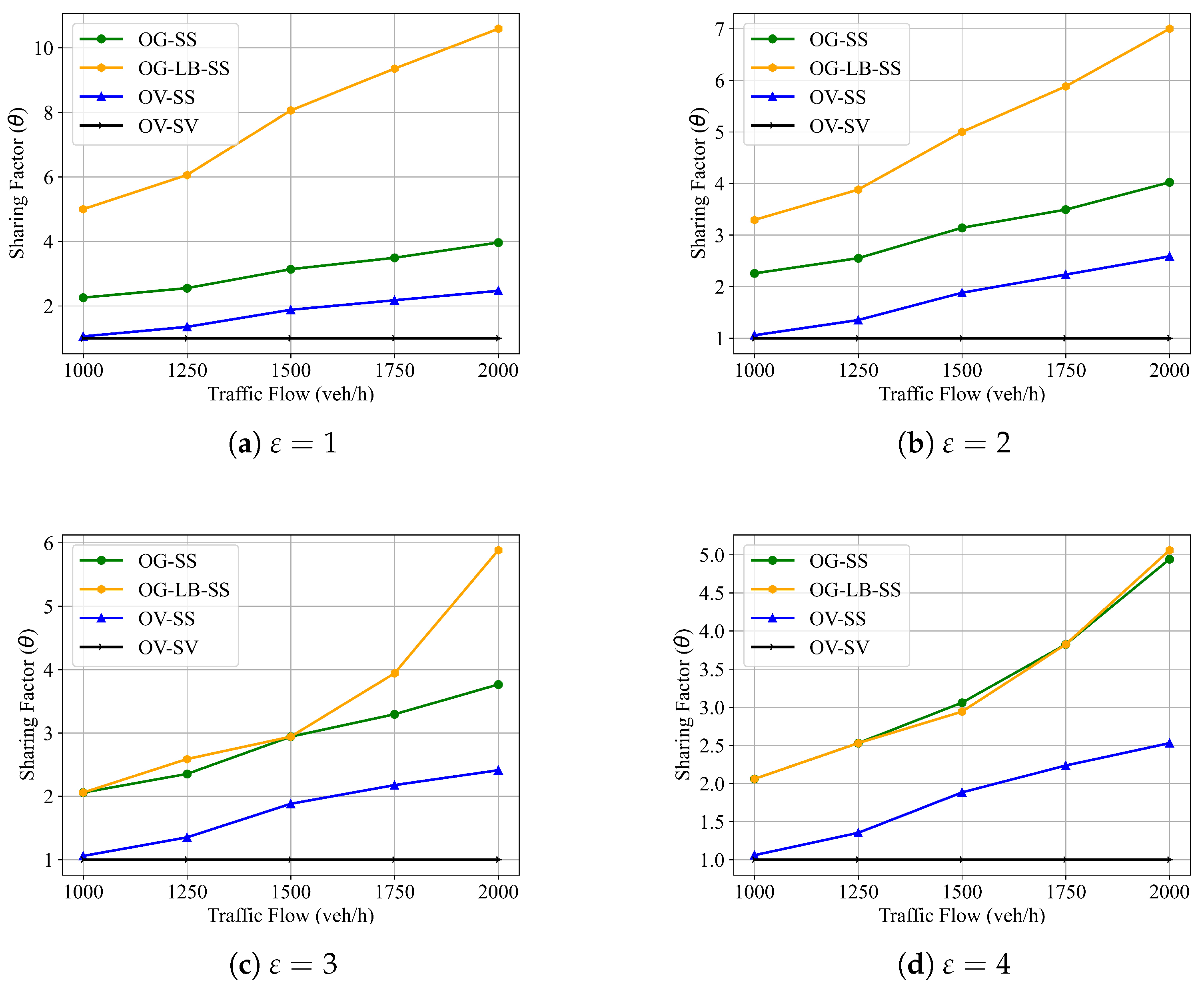Cooperative Environmental Perception Task Offloading for Connected and Autonomous Vehicles
Abstract
:1. Introduction
2. Literature Reviews
2.1. Cooperative Perception for CAVs
2.2. Perception Task Offloading for CAVs
3. System Model
3.1. System Architecture
3.2. Perception Task Model
3.3. Requiring Areas of Perception Tasks
3.4. Shareability Factor of the Task Result
3.5. Delay Model
3.5.1. Transmission Delay
3.5.2. Processing Delay
3.6. Optimization Formulation
4. Methods
4.1. Offloading Based on Greedy Sharing Strategy
| Algorithm 1 Offloading Based on Greedy Sharing Strategy (OG). |
Input: Task set and computing resource F of edge server. Output: The set of offloaded tasks .
|
4.2. Offloading Based on Greedy Sharing Strategy with Load Balance
| Algorithm 2 Offloading Based Greedy on Sharing Strategy with Load Balance (OG-LB). |
Input: Task , computing resource of edge server F, the number of tasks that a vehicle can deal with at most in a perception cycle Output: The set of offloaded tasks .
|
5. Results and Discussion
5.1. Experimental Settings
- Offloading based on greedy algorithm (denoted as OG). As shown in Algorithm 1, the tasks are selected to be offloaded based on the weight .
- Offloading based on greedy algorithm with load balance (denoted as OG-LB). As shown in Algorithm 2, the computation load of each vehicle is taken into account.
- Offloading based on the generation order in the vehicle (denoted as OV). In this scheme, the shareability of the tasks are not considered.
- The task result is shared by the server (denoted as SS). This is our proposed scheme. In this scheme, the result of the offloaded task is broadcast by the server to all vehicles in the requiring areas through infrastructure-to-vehicle (I2V) communications.
- The task result is shared by the vehicles (denoted as SV). This is a traditional cooperative perception scheme in vehicular edge computing. In this scheme, the edge server sends the result of the offloaded task to the task-generated vehicle, then the vehicle sends the result to other vehicles through vehicle-to-vehicle (V2V) communications.
5.2. Results Analysis
5.2.1. Delay
5.2.2. Shareability Factor
6. Conclusions
Author Contributions
Funding
Data Availability Statement
Conflicts of Interest
Abbreviations
| CAV | Connected and Autonomous Vehicle |
| VEC | Vehicular Edge Computing |
| V2V | Vehicle-to-Vehicle |
| V2I | Vehicle-to-Infrastructure |
| AP | Access Point |
References
- Muhammad, K.; Ullah, A.; Lloret, J.; Del Ser, J.; de Albuquerque, V.H.C. Deep learning for safe autonomous driving: Current challenges and future directions. IEEE Trans. Intell. Transp. Syst. 2020, 22, 4316–4336. [Google Scholar] [CrossRef]
- Zhang, J. Sensor data validation and driving safety in autonomous driving systems. arXiv 2022, arXiv:2203.16130. [Google Scholar]
- Trager, J.; Kalová, L.; Pagany, R.; Dorner, W. Warning apps for road safety: A technological and economical perspective for autonomous driving–the warning task in the transition from human driver to automated driving. Int. J. Hum.-Comput. Interact. 2021, 37, 363–377. [Google Scholar] [CrossRef]
- Kumar, V.R.; Yogamani, S.; Rashed, H.; Sitsu, G.; Witt, C.; Leang, I.; Milz, S.; Mäder, P. Omnidet: Surround view cameras based multi-task visual perception network for autonomous driving. IEEE Robot. Autom. Lett. 2021, 6, 2830–2837. [Google Scholar] [CrossRef]
- Parekh, D.; Poddar, N.; Rajpurkar, A.; Chahal, M.; Kumar, N.; Joshi, G.P.; Cho, W. A review on autonomous vehicles: Progress, methods and challenges. Electronics 2022, 11, 2162. [Google Scholar] [CrossRef]
- Lopac, N.; Jurdana, I.; Brnelić, A.; Krljan, T. Application of laser systems for detection and ranging in the modern road transportation and maritime sector. Sensors 2022, 22, 5946. [Google Scholar] [CrossRef]
- Hou, W.; Li, W.; Li, P. Fault diagnosis of the autonomous driving perception system based on information fusion. Sensors 2023, 23, 5110. [Google Scholar] [CrossRef]
- Yang, Q.; Fu, S.; Wang, H.; Fang, H. Machine-learning-enabled cooperative perception for connected autonomous vehicles: Challenges and opportunities. IEEE Netw. 2021, 35, 96–101. [Google Scholar] [CrossRef]
- Liu, S.; Liu, L.; Tang, J.; Yu, B.; Wang, Y.; Shi, W. Edge computing for autonomous driving: Opportunities and challenges. Proc. IEEE 2019, 107, 1697–1716. [Google Scholar] [CrossRef]
- Lu, S.; Shi, W. The emergence of vehicle computing. IEEE Internet Comput. 2021, 25, 18–22. [Google Scholar] [CrossRef]
- Liu, L.; Chen, C.; Pei, Q.; Maharjan, S.; Zhang, Y. Vehicular edge computing and networking: A survey. Mob. Netw. Appl. 2021, 26, 1145–1168. [Google Scholar] [CrossRef]
- Zhang, J.; Guo, H.; Liu, J.; Zhang, Y. Task offloading in vehicular edge computing networks: A load-balancing solution. IEEE Trans. Veh. Technol. 2019, 69, 2092–2104. [Google Scholar] [CrossRef]
- Guo, H.; Rui, L.; Gao, Z. V2V task offloading algorithm with LSTM-based spatiotemporal trajectory prediction model in SVCNs. IEEE Trans. Veh. Technol. 2022, 71, 11017–11032. [Google Scholar] [CrossRef]
- Wang, H.; Lv, T.; Lin, Z.; Zeng, J. Energy-delay minimization of task migration based on game theory in MEC-assisted vehicular networks. IEEE Trans. Veh. Technol. 2022, 71, 8175–8188. [Google Scholar] [CrossRef]
- Zhang, D.; Cao, L.; Zhu, H.; Zhang, T.; Du, J.; Jiang, K. Task offloading method of edge computing in internet of vehicles based on deep reinforcement learning. Clust. Comput. 2022, 25, 1175–1187. [Google Scholar] [CrossRef]
- Ye, Q.; Shi, W.; Qu, K.; He, H.; Zhuang, W.; Shen, X.S. Learning-based computing task offloading for autonomous driving: A load balancing perspective. In Proceedings of the IEEE International Conference on Communications (ICC), Montreal, QC, Canada, 14–23 June 2021; pp. 1–6. [Google Scholar]
- Jang, J.; Tulkinbekov, K.; Kim, D.H. Task offloading of deep learning services for autonomous driving in mobile edge computing. Electronics 2023, 12, 3223. [Google Scholar] [CrossRef]
- Pliatsios, D.; Sarigiannidis, P.; Lagkas, T.D.; Argyriou, V.; Boulogeorgos, A.A.A.; Baziana, P. Joint wireless resource and computation offloading optimization for energy efficient internet of vehicles. IEEE Trans. Green Commun. Netw. 2022, 6, 1468–1480. [Google Scholar] [CrossRef]
- Ku, Y.J.; Baidya, S.; Dey, S. Uncertainty-aware task offloading for multi-vehicle perception fusion over vehicular edge computing. IEEE Trans. Veh. Technol. 2023, 1–16, early access. [Google Scholar] [CrossRef]
- Ghorai, P.; Eskandarian, A.; Kim, Y.K.; Mehr, G. State estimation and motion prediction of vehicles and vulnerable road users for cooperative autonomous driving: A survey. IEEE Trans. Intell. Transp. Syst. 2022, 23, 16983–17002. [Google Scholar] [CrossRef]
- Yuan, Y.; Cheng, H.; Sester, M. Keypoints-based deep feature fusion for cooperative vehicle detection of autonomous driving. IEEE Robot. Autom. Lett. 2022, 7, 3054–3061. [Google Scholar] [CrossRef]
- Lei, Z.; Ren, S.; Hu, Y.; Zhang, W.; Chen, S. Latency-aware collaborative perception. In Proceedings of the 17th European Conference on Computer Vision (ECCV), Tel Aviv, Israel, 23–27 October 2022; pp. 316–332. [Google Scholar]
- Zhou, P.; Kortoçi, P.; Yau, Y.P.; Finley, B.; Wang, X.; Braud, T.; Lee, L.H.; Tarkoma, S.; Kangasharju, J.; Hui, P. AICP: Augmented informative cooperative perception. IEEE Trans. Intell. Transp. Syst. 2022, 23, 22505–22518. [Google Scholar] [CrossRef]
- Ahmed, M.; Raza, S.; Mirza, M.A.; Aziz, A.; Khan, M.A.; Khan, W.U.; Li, J.; Han, Z. A survey on vehicular task offloading: Classification, issues, and challenges. J. King Saud Univ. Comput. Inf. Sci. 2022, 34, 4135–4162. [Google Scholar] [CrossRef]
- Lv, P.; Xu, W.; Nie, J.; Yuan, Y.; Cai, C.; Chen, Z.; Xu, J. Edge computing task offloading for environmental perception of autonomous vehicles in 6G networks. IEEE Trans. Netw. Sci. Eng. 2023, 10, 1228–1245. [Google Scholar] [CrossRef]
- Xiao, Z.; Shu, J.; Jiang, H.; Min, G.; Chen, H.; Han, Z. Perception task offloading with collaborative computation for autonomous driving. IEEE J. Sel. Areas Commun. 2023, 41, 457–473. [Google Scholar] [CrossRef]
- Krijestorac, E.; Memedi, A.; Higuchi, T.; Ucar, S.; Altintas, O.; Cabric, D. Hybrid vehicular and cloud distributed computing: A case for cooperative perception. In Proceedings of the IEEE Global Communications Conference (GLOBECOM), Taipei, Taiwan, China, 7–11 December 2020; pp. 1–6. [Google Scholar]
- Feng, W.; Zhang, N.; Li, S.; Lin, S.; Ning, R.; Yang, S.; Gao, Y. Latency minimization of reverse offloading in vehicular edge computing. IEEE Trans. Veh. Technol. 2022, 71, 5343–5357. [Google Scholar] [CrossRef]
- Jin, Z.; Zhang, C.; Zhao, G.; Jin, Y.; Zhang, L. A context-aware task offloading scheme in collaborative vehicular edge computing systems. KSII Trans. Internet Inf. Syst. 2021, 15, 383–403. [Google Scholar]
- Sun, Y.; Guo, X.; Song, J.; Zhou, S.; Jiang, Z.; Liu, X.; Niu, Z. Adaptive learning-based task offloading for vehicular edge computing systems. IEEE Trans. Veh. Technol. 2019, 68, 3061–3074. [Google Scholar] [CrossRef]
- Li, M.; Gao, J.; Zhao, L.; Shen, X. Adaptive computing scheduling for edge-assisted autonomous driving. IEEE Trans. Veh. Technol. 2021, 70, 5318–5331. [Google Scholar] [CrossRef]
- Qin, Z.; Leng, S.; Zhou, J.; Mao, S. Collaborative edge computing and caching in vehicular networks. In Proceedings of the IEEE Wireless Communications and Networking Conference (WCNC), Seoul, Republic of Korea, 25–28 May 2020; pp. 1–6. [Google Scholar]
- Liu, Z.; Dai, P.; Xing, H.; Yu, Z.; Zhang, W. A distributed algorithm for task offloading in vehicular networks with hybrid fog/cloud computing. IEEE Trans. Syst. Man Cybern. Syst. 2021, 52, 4388–4401. [Google Scholar] [CrossRef]
- Chen, C.; Zeng, Y.; Li, H.; Liu, Y.; Wan, S. A multihop task offloading decision model in MEC-enabled internet of vehicles. IEEE Internet Things J. 2022, 10, 3215–3230. [Google Scholar] [CrossRef]
- Ju, Y.; Chen, Y.; Cao, Z.; Wang, H.; Liu, L.; Pei, Q.; Kumar, N. Learning based and physical-layer assisted secure computation offloading in vehicular spectrum sharing networks. In Proceedings of the IEEE Conference on Computer Communications Workshops (INFOCOM WKSHPS), Virtual, 2–5 May 2022; pp. 1–6. [Google Scholar]
- Javed, M.A.; Zeadally, S. AI-empowered content caching in vehicular edge computing: Opportunities and challenges. IEEE Netw. 2021, 35, 109–115. [Google Scholar] [CrossRef]
- Ma, C.; Zhu, J.; Liu, M.; Zhao, H.; Liu, N.; Zou, X. Parking edge computing: Parked-vehicle-assisted task offloading for urban VANETs. IEEE Internet Things J. 2021, 8, 9344–9358. [Google Scholar] [CrossRef]









| Parameter | Value | Denotation |
|---|---|---|
| Bandwidth for V2I | 40 MHz [12] | |
| Bandwidth for V2V | 10 MHZ [34] | |
| Transmission power for uplink | 23 dBm [28] | |
| Transmission power for downlink | 33 dBm [28] | |
| Transmission power for V2V | 10 dBm [35] | |
| Noise power | −100 dBm [12] | N |
| Path loss index | 3 | |
| Size of task | 1–3 MB | l |
| Ratio of result size to task size | 0.001–0.01 | |
| Maximum tolerable latency | 100 ms [36] | |
| Server computing frequency | 8 GHz [37] | F |
| Compute capacity | 10 period/bit | C |
| Simulation scenario | straight; intersection | |
| The coverage range of an AP | 200 m | |
| The size of a requiring area | 100 m × 4 m | |
| The size of traffic flow | veh/h |
Disclaimer/Publisher’s Note: The statements, opinions and data contained in all publications are solely those of the individual author(s) and contributor(s) and not of MDPI and/or the editor(s). MDPI and/or the editor(s) disclaim responsibility for any injury to people or property resulting from any ideas, methods, instructions or products referred to in the content. |
© 2023 by the authors. Licensee MDPI, Basel, Switzerland. This article is an open access article distributed under the terms and conditions of the Creative Commons Attribution (CC BY) license (https://creativecommons.org/licenses/by/4.0/).
Share and Cite
Lv, P.; Huang, J.; Liu, H. Cooperative Environmental Perception Task Offloading for Connected and Autonomous Vehicles. Electronics 2023, 12, 3714. https://doi.org/10.3390/electronics12173714
Lv P, Huang J, Liu H. Cooperative Environmental Perception Task Offloading for Connected and Autonomous Vehicles. Electronics. 2023; 12(17):3714. https://doi.org/10.3390/electronics12173714
Chicago/Turabian StyleLv, Pin, Jie Huang, and Heng Liu. 2023. "Cooperative Environmental Perception Task Offloading for Connected and Autonomous Vehicles" Electronics 12, no. 17: 3714. https://doi.org/10.3390/electronics12173714
APA StyleLv, P., Huang, J., & Liu, H. (2023). Cooperative Environmental Perception Task Offloading for Connected and Autonomous Vehicles. Electronics, 12(17), 3714. https://doi.org/10.3390/electronics12173714






